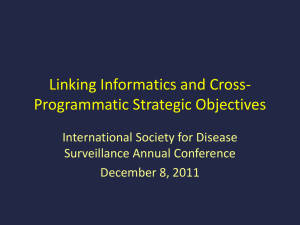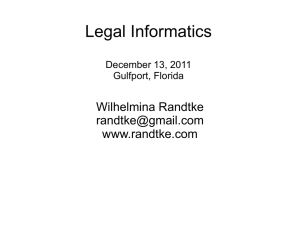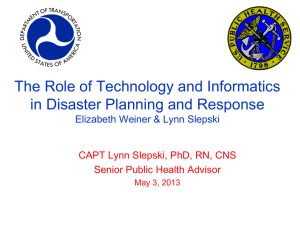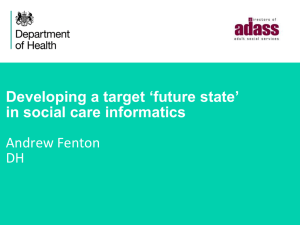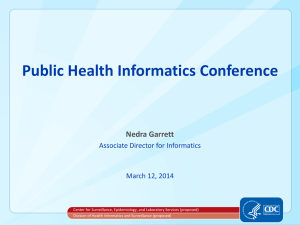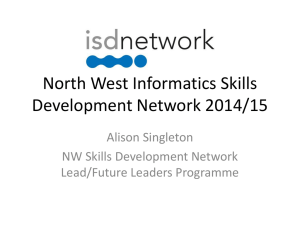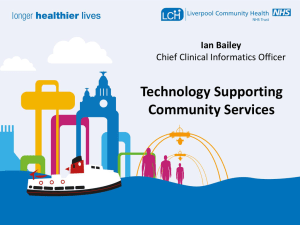Who is Mackenzie Health (MH)?
advertisement
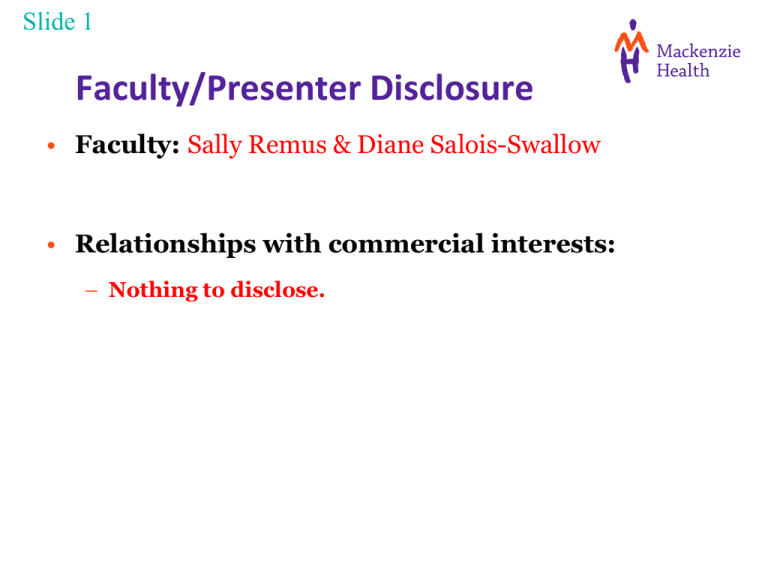
Slide 1 Faculty/Presenter Disclosure • Faculty: Sally Remus & Diane Salois-Swallow • Relationships with commercial interests: – Nothing to disclose. Building capacity, operational readiness & sustainability to realize a ‘SMART’ hospital design & build eHealth 2013 Ottawa, ON May 29th, 2013 Sally Remus, RN, BScN, MScN Director, Health Informatics & Practice Diane Salois-Swallow RN, BScN, M. Ed., Chief Information Officer Agenda • Who is Mackenzie Health (MH) ? • MOHLTC mandate – Design a ‘smart’ hospital • New structures & nursing informatics roles/skill sets • Current Issues and Challenges • Next steps – – Good old days vs New reality – Create a climate of operational readiness – Future possibilities through innovative NI roles • Questions/Discussion Who is Mackenzie Health (MH)? • Large community hospital serving Richmond Hill, Vaughan and other parts of York Region • Expanding to a two-site model: new hospital in Vaughan in planning stages Existing Mackenzie Richmond Hill Hospital Mackenzie Vaughan Hospital Proposed Concept MH Quick Facts Current State: Future State: • Opened in 1963, Mackenzie • Mackenzie Health will include two Health serves 500,000+ residents hospitals, the future “Mackenzie in Southwest York Region Vaughan Hospital” and the existing Mackenzie Richmond Hill Hospital • Mackenzie Richmond Hill ~ 600 beds Hospital (formerly known as York – construction expected to begin in Central Hospital) - 488 Beds 2015/16 • Second largest employer in Southwest York Region • Annual budget of $250 million – new hospital (second site) scheduled to be fully operational by 2018/19 • Southwest York Region is known as one of the fastest growing and most diverse communities in Canada. – 1st new hospital to be built in the Southwest York Region in 50 years. MOHLTC Mandate: Design & Build a ‘Smart’ Hospital MH’s ‘Smart’ Hospital vision : • ‘Paperless’ environment where all information is digital • Systems are automated & interoperable • Communications are multi-modal & digital • People are equipped for mobility • All technologies are IP addressable and Interoperable To do this requires a ‘state of the art’ IT infrastructure ICAT 6 28th March 2012 7 Copyright - Vantage Business Management Services, 2013 ICAT components that maximize automation include: • Electronic Patient Record & Other ‘Enabling Clinical Technologies’ • Automated Patient Bedside Terminals & Bedside Infrastructure • Fully Automated Pharmacy, Laboratory, Materials Management & Building Systems • Integrated Tube Transport System & Infrastructure • Unified Communications – Integrates voice, data & image into digital/electronic format • Auto Guided Vehicles (AGVs) • Enterprise Service Bus (ESB) 8 Operationalizing ICAT & its components requires answers to the following questions: What do the logistics and material’s management distribution systems/processes look like? What do the drug delivery/distribution & drug administration systems/processes look like? What does bedside care look like? (e.g., bedside terminals, etc.) What does ‘unified communications’ look like? What does specimen collection/analysis and results processing/reporting look like from bedside to laboratory? What does environmental cleaning look like in clinical vs. nonclinical areas ? For example – ‘terminal room cleaning’, etc… Nursing informatics roles are essential in ‘brokering’ and ‘translating’ in partnership with key clinical stakeholders, the answers… 9 Mackenzie Health Organizational Structure Mackenzie Health Organizational Structure eHealth through informatics & practice @ MH Medical Informatics Clinical Informatics Health Information Management Health Care Informatics Nursing Informatics Embracing Enabling Technologies & Innovation in Patient Care through Informatics Adapted from: Englebart, S, Nelson, R. (2002). Health Care Informatics – An Interdisciplinary Approach, p. xviii; Eysenbach, G. (2001). What is eHealth. J Med Internet Res 3(2):e20. Nursing Informatics - New Roles and Skills Sets Director, Health Informatics & Practice will : • facilitate the corporate mandate & realization of the new ‘Smart’ hospital build (MVH) and MH’s eHealth agenda. • position MH to be an industry leader in launching a transformative practice leadership model and governance structure that will enable the delivery of a ‘world class health experience that is patient focused, results driven, integrated, and sustainable, critically dependent upon information and communication technologies’ essential informatics skills & knowledge. • position MH to realize the benefits of patient safety, quality care delivery models and knowledge driven care by the application of informatics’ skills & knowledge to execute ‘state of the art’ enabling information & communication technologies. Role alignment with industry trends: • Informatics competencies & certification – ANA (2001, 2008); HIMSS, COACH-HIMSS • Employment trends - new informatics’ roles – Obama Care & Accountable Care Organization (ACO) Act influencing the emergence of CNIO roles to compliment CMIO roles • Academic preparation of nurses – TIGER, CASN, RNAO • Industry Reports – 2003 IOM, Amara 2000 Current Issues and Challenges Creating & sustaining a climate of operational readiness to meet the build/design characteristics of the new ‘Smart’ hospital (MVH) supported by a robust ‘state of the art’ ICT infrastructure: • Introduce and nurture a ‘new way of thinking’, understanding and endorsement of the MVH ‘smart’ hospital vision • Introduce transitional clinical system building blocks to meet HIMSS – EMRAM Stage 6 – CPOE with full closed loop medication administration checking & Physician documentation • Introduce transitional ‘state of the art’ technologies that further the ‘smart’ hospital vision: – ‘Smart’ beds; Nurse Call Bell System that aligns with a unified communication’s infrastructure Current Issues and Challenges cont. • Design and introduce new work flow practices/processes & policy/procedures that are scalable/flexible to support successful transition to MVH ‘smart’ hospital. • Build internal resource capacity to transition successfully – Workforce preparation – Develop all hospital staff (e.g.., nursing /allied health/physicians) with the requisite informatics skills & knowledge to leverage the state of the art ICT infrastructure Recruit/prepare clinical informatics team to design clinical/business systems that meet the ‘smart’ hospital vision & eHealth agenda/mandates – Consumer preparation – Educate MVH & MRHH communities to understand & leverage new ‘smart’ hospital services & offerings that will create MH providing a ‘world class health experience’. o E.g.., consumer friendly access to self services - patient scheduling/registration ; chronic disease management The Good Old Days…… 16 Create an ‘operational readiness’ climate via a User Engagement Strategy #2 #3 #1 Reference: Remus & dela Cruz. (2007). CNIA Conference Proceedings, Toronto, ON #4 The New Reality! 18 A glimpse into our future possibilities with innovative nursing informatics leadership roles … http://www.youtube.com/watch?v=gxz9ZVvdu Gc Thank You!

